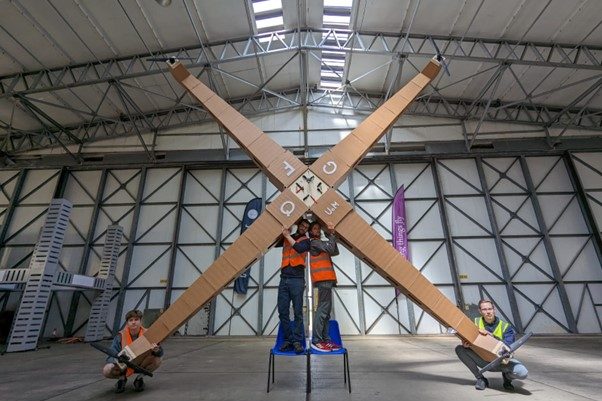The University of Manchester has produced what is believed to be the world’s largest quadcopter drone – mostly from a cardboard-like material.
Engineers at the Russell Group university have made and flown the drone, which consists of a lightly weighted substance called foamboard.
Its design means the device is currently measures at 6.4m from corner to corner, and remarkably weighs around 24.5kg – 0.5kg lower than the Civil Aviation Authority’s upper weight limit.
The special design of the drone, which is referred to as the Giant Foamboard Quadcopter (GFQ) by its creators, means it is unlike any other throughout the world.
According to the University of Manchester, it is believed there is presently no record of a purpose-built uncrewed quadcopter with four rotors of any weight class which is larger than their vehicle.
GFQ is powered by four electric motors running off a 50-volt battery pack. It also has an on-board flight control system and can fly autonomously.
The project began as a curiosity-driven venture to aid the creativity of the university’s students in the realm of aerospace engineering – specifically using low-cost, environmentally friendly materials.
Over the last year, a team of undergraduates helped build and test various critical aspects of the structure.
We've designed and flown the world’s largest quadcopter drone!
— UoM Science and Engineering (@UoMSciEng) October 23, 2023
The drone, made from a cardboard-like material called foamboard, measures 6.4m (21 ft) corner to corner and weighs 24.5kg – 0.5kg less than the weight limit set by the Civil Aviation Authority. 🤯 pic.twitter.com/Y0GDVGw52M
Researchers hope this demonstration will inspire the next generation of designers to think about sustainability from a completely new perspective.
It is thought that future iterations of this vehicle type could be designed to carry large payloads over short distances or used as a drone ‘mothership’ in air-to-air docking experiments.
This may include military use or bird’s eye view photography.
The drone was first flown in July this year at the Snowdonia Aerospace Centre during an event visited by universities from across the United Kingdom.
Bill Crowther, a Professor of Aerospace Engineering at The University of Manchester, said: “Working with foamboard provides a unique learning opportunity for students to experiment with innovative structural designs.
“Although the material is strong for its weight, it requires significant engineering skill to exploit its structural potential.
“Ultimately, with this design you are holding up 25kg of aircraft with just a few strategically placed pieces of paper – that’s the art of the possible.”
The team are now looking to optimise the design of the Giant Foamboard Quadcopter further.
Dan Koning, a research engineer at The University of Manchester, who led the design and build of the vehicle, said: “The lessons we’ve learned from this pathfinder vehicle should help us add a few more metres to the next one. But to go 50% bigger, you’ve got to get 100% smarter.”
Featured image credit: University of Manchester




